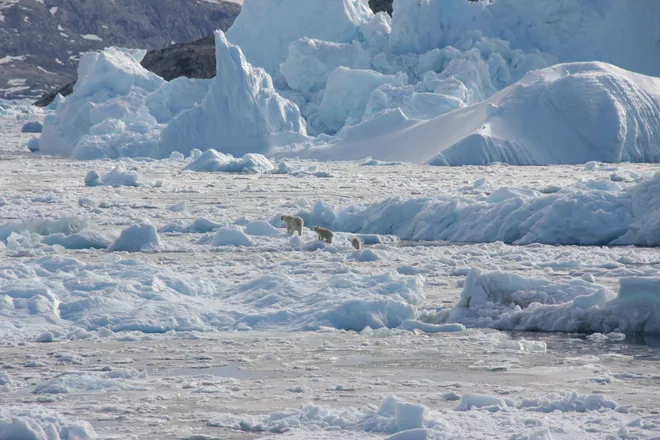After all, there is a connection between global warming and polar bears. It’s also not a good one.

Polar bears deal with changing climate conditions in Greenland. (Source: Thomas W. Johansen/NASA Oceans Melting Greenland)
Reducing Sea Ice Due to Global Warming
For the first time, scientists can quantify the impact of global warming on polar bear cub survival, according to a new study published on Thursday. This is significant because, while scientists have known for years that a lack of sea ice can be disastrous for polar bears, there was no mechanism in place to assess the precise impact of human-caused climate change on the iconic animal.
The combustion of fossil fuels such as oil, gas, and coal produces greenhouse gases such as carbon dioxide and methane. These gases have caused the warming of the world’s atmosphere and seas, resulting in less sea ice in the Arctic. Polar bears hunt on sea ice, and when the ice melts, they are forced onto land, where they cannot find food. Polar bears must fast for longer periods as Arctic Sea ice melts in reaction to rising temperatures. “Until now, scientists had not provided quantitative evidence to link greenhouse gas emissions to population decline,” said study co-author Cecilia Bitz, an atmospheric sciences professor at the University of Washington, in a statement.
The loss of sea ice may eventually lead to extinction. The combustion of fossil fuels such as oil, gas, and coal produces greenhouse gases such as carbon dioxide and methane. These gases have warmed the world’s atmosphere and seas, resulting in less sea ice in the Arctic. Polar bears hunt on sea ice, and when the ice melts, they are forced onto land, where they cannot find food. Polar bears must fast for longer periods as Arctic Sea ice melts in reaction to rising temperatures.
READ ALSO: Beat The Heat: How to Stay Cool in the Hot Weather While Camping
Global Warming Endangers Polar Bear Species
The study has policy implications as well because it allows for a systematic assessment of how future suggested changes may affect polar bears. Researchers believe it circumvents a legal stumbling block in the Endangered Species Act that barred the federal government from taking climate change into account when reviewing operations such as oil and gas extraction.
According to the Department of the Interior, greenhouse gas emissions cannot be considered when assessing a project’s impact on endangered species unless its emissions impact can be differentiated from previous world emissions. “What’s relevant for policy is emissions,” not atmospheric concentrations, according to Bitz.
Author Steven Amstrup of Polar Bear International, who is the study’s primary author, said, “I consider this the most important publication of my career. It clarifies recent population shifts, resolves a policy conundrum for the US, and offers guidance to other nations thinking about undertaking development initiatives, giving polar bears the protection, they need. Amstrup also thinks that many other species, like sea turtles or coral reefs, can benefit from applying the new study’s methodologies.
“I hope the United States government fulfills its legal obligation to protect polar bears by limiting greenhouse gas emissions from human activity,” Bitz added. I hope that investments be made in existing fossil fuel alternatives as well as the development of new technologies that reduce greenhouse gas emissions.”
The findings were reported in the journal Science.
READ ALSO: Dry Days Are Ahead for This Week’s Weather Condition in Alabama

















































